Get up and go: How the walking trend is making strides in Singapore


Walking is having its moment.
If you have been scrolling through social media lately, you might have stumbled upon #hotgirlwalk, showing women incorporating outdoor walks into their fitness routines.
The hashtag has been trending globally on short-video app TikTok since 2021, with the clips having been viewed more than 1.2 billion times.
Other viral sensations on the platform include #NatureWalk videos – people walking or hiking in nature – with 250.7 million views, and #WalkingBackwards videos – trekking around in reverse to improve balance and reduce knee pains – with 16.2 million views.
Then there is #SilentWalking, for those who prefer walking without headphones or any audio distractions – clips with that hashtag have garnered a total of 879,000 views.
The walking trend is also gaining traction in Singapore. A quick search for “walking group Singapore” throws up more than 20 groups on Facebook, including one – Singapore Walking Group – with more than 10,000 members.
On Meetup.com, a social networking site, niche walking groups abound. There are groups for people who want to make new friends, improve their Japanese, meditate while walking or practise Nordic walking (walking with specially designed poles).
Walking groups appear to be especially popular with seniors. The Straits Times attended walks with four different groups over two weeks and found that most participants are in their 50s and 60s.
Dr Lim Boon Leng, a psychiatrist from Dr BL Lim Centre for Psychological Wellness, says: “These groups meet both the physical activity and social needs of seniors, who are now better educated and more health conscious.
“Walking groups help them maintain an active lifestyle and connect with peers, combating loneliness. The structure and routine provided by these groups can also give seniors a sense of purpose and regular social engagements.”
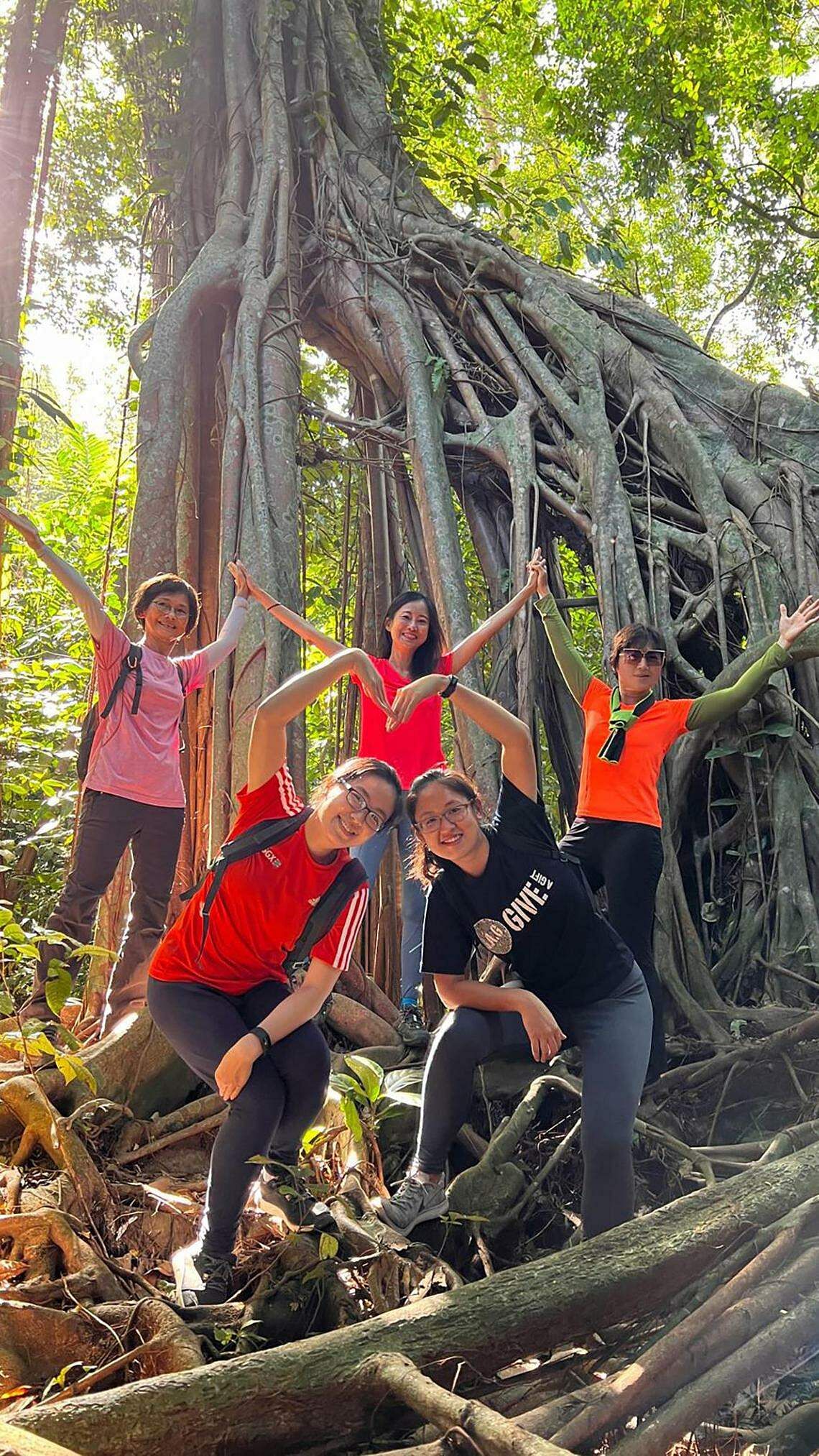
The interest in group walks surged during the Covid-19 pandemic.
In 2020, Ms Olevia Cheong, 55, found herself in Singapore for an extended period of time for the first time in years.
Before the pandemic grounded flights and restricted international travel, the freelance tour manager would lead about 10 tour groups a year to Europe.
In November 2020, a few months after the circuit breaker period ended, she organised her first group walk.
“We were just friends going for a walk together. We wanted to get some outdoor exercise and help everybody keep in shape after being cooped up indoors for so long,” says Ms Cheong, who trekked for 2½ hours through the nature trail in Clementi Forest with nine pals.
They enjoyed the walk so much that they decided to do it every alternate Saturday.
Next, she started Awesome One – a Facebook group that now has more than 700 members. There, she shares information about upcoming group walks, the exercise classes she leads, and the overseas tours that she organises.
“Since I was young, I’ve always been the one initiating meet-ups among friends,” says Ms Cheong, whose walking group has explored Dover Forest, Sentosa and Lazarus Island.
“Before Covid-19, I had never explored these places,” she says, adding that her main goal is to encourage her friends to lead an active lifestyle.
“During the pandemic, I started to realise that people get depressed when they don’t leave their homes. People are not meant to live alone. My walks became a way for friends to reconnect.”
She noticed friendships blossoming during the walks.
In April 2024, she and three people from the walking group went on an eight-day holiday to India. They visited the Taj Mahal, a Unesco World Heritage Site, and experienced the tulip festival in Srinagar, Kashmir.
Dr Rathi Mahendran from Mind Care Clinic says walking is one of the easiest ways to stay active.
“Walking as a form of aerobic exercise has the most evidence for treating symptoms of depression,” adds the psychiatrist who, in addition to her clinical practice, is involved in mental health research.
She quotes a 2023 paper from peer-reviewed journal Current Psychology that systematically reviewed 17 other studies.
The paper suggests that nature-based walking interventions can mitigate stress and other mental health issues.
“Walking with a group of like-minded persons with a common purpose is enjoyable and contributes to a sense of well-being,” she adds.
Mr Tan Hock Seng, 65, spent more than four decades working as an operations manager for several multinational corporations.
The self-described workaholic, who was the sole breadwinner for his family of six, was also a smoker who did not exercise.
In June 2018, his life flipped upside down. Then 58, he was about to light a cigarette in a carpark one morning when he suddenly saw a white light and felt the need to lie down. A passer-by called for an ambulance.
At the hospital, doctors told him that he had suffered a stroke that left him paralysed on the left side of his body. He also lost his sight and hearing in his left eye and ear, respectively.
“When I woke up, I knew that I had to do something. Doctors told me the possible cause was high cholesterol coupled with habitual smoking,” says Mr Tan, who currently works as a compliance officer.
He started walking on the advice of a cancer survivor friend, who extolled its benefits. He began with short walks under his block and progressed to longer ones, walking from Yew Tee to his old neighbourhood in Everton Park.
He also searched for heritage trails on the National Heritage Board website.
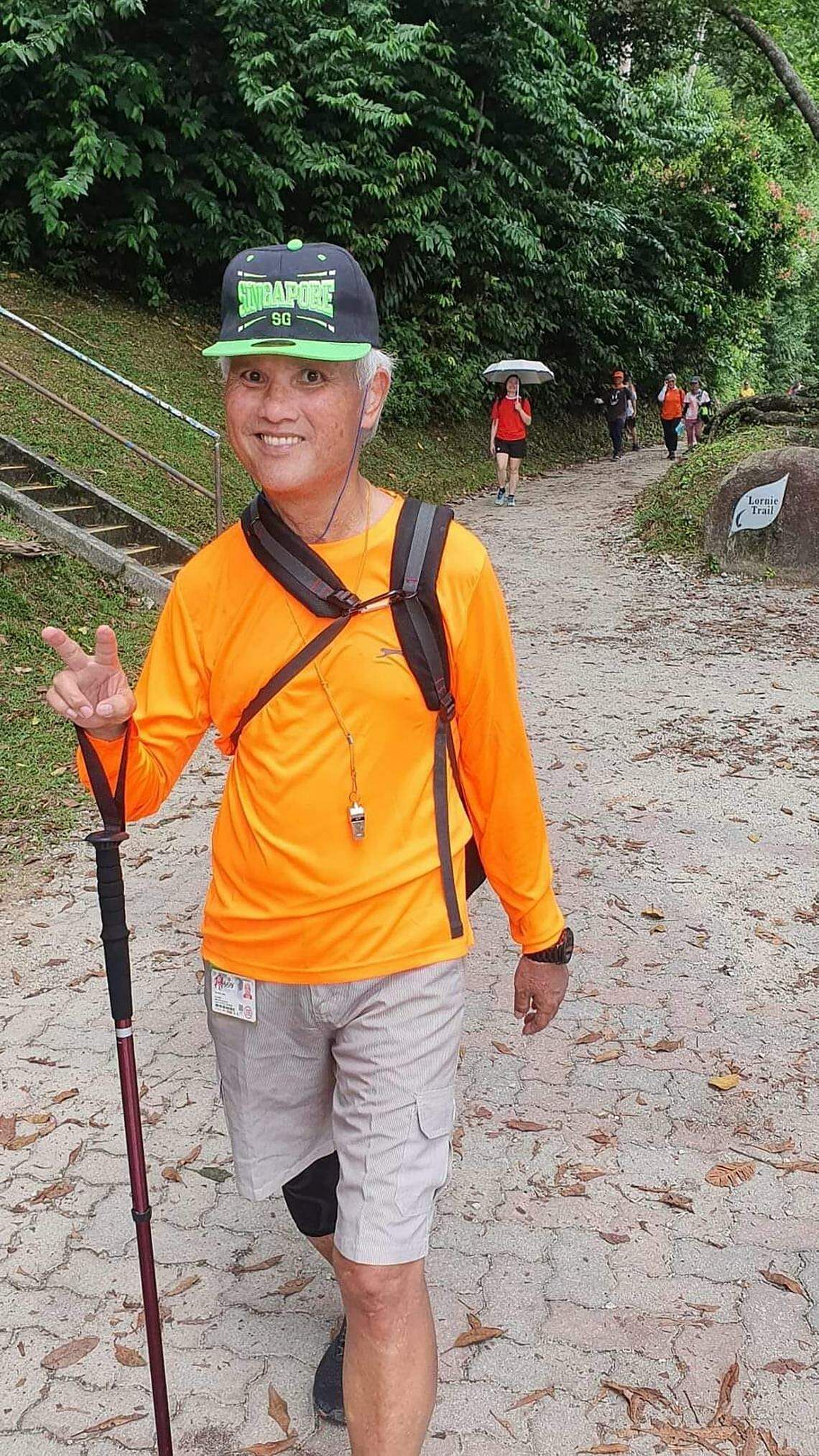
In April 2023, he came across a Facebook post by Mr Won Tzyy-ya, 65, encouraging people to join his walking group LongwalkSG.
After Mr Won assuaged his fears about being able to keep up with the group’s regulars, Mr Tan had his first group walk experience on June 18, 2023, exploring Bukit Brown Cemetery.
He was relieved to find out that there were many rest points, and impressed by how the leader of the walk and other members looked out for him.
Since then, he has not missed the group’s weekly Sunday walk, covering between 25km and 30km each time.
Having regular walks, along with diligently taking his medication and changing his diet to include more fibre, has helped him improve his cholesterol levels significantly.
Gastrointestinal expert Ganesh Ramalingam has met many patients who have improved their health by leaps and bounds through walking.
Many studies show that gradual and low-intensity walks inhibit the genes that contribute to weight gain and help patients to lose weight, he says. Walking can also reduce the risk of developing cancers, specifically breast cancer, the main form of cancer afflicting women in Singapore, and colorectal cancer, the type of cancer most men here suffer from.
“Low intensity, longer walks are much better for longevity and injury prevention. Go slow, gradually build up, do longer periods but with less intensity,” advises Dr Ramalingam.
Dr June Quek, a senior principal physiotherapist at Singapore General Hospital, agrees.
“If you want to do long walks, you have to start gradually. You cannot suddenly go from zero to four hours of walking a day. You might end up suffering some level of discomfort somewhere.”
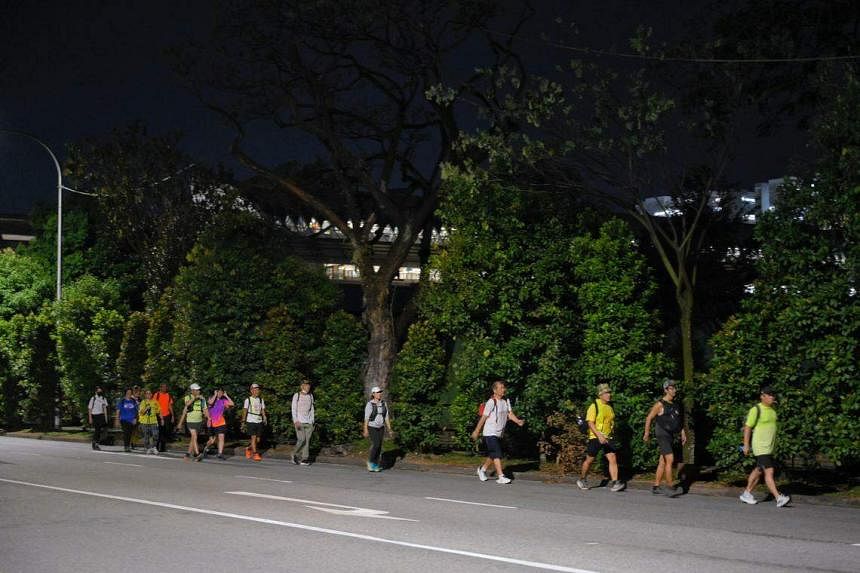
According to the National Population Health Survey 2022, the proportion of residents engaging in sufficient total physical activity dropped from 84.6 per cent in 2019 to 74.9 per cent in 2022.
This decrease is likely due to a reduction in commuting from hybrid work arrangements, which has not returned to pre-Covid-19 levels.
Dr Quek says walking, an exercise with low barriers to entry, is a great way to kick-start a more active lifestyle.
“Any kind of walking is great for anyone. It’s an easy exercise, it’s free – as long as you have a pair of shoes, you can get up and go,” she adds.
Health professionals say walking could also help to alleviate the problem of senior isolation.
A 2015 study by Duke-NUS Medical School’s Centre for Ageing Research and Education found that two in five Singaporeans aged 62 and older are lonely.
This can be attributed to families getting smaller, leaving seniors with fewer people to rely on.
Dr Lim often encounters patients young and old who suffer from depression related to social isolation.
“Loneliness and social isolation among seniors can have severe mental health consequences. Isolation can lead to a lack of purpose and increased feelings of worthlessness,” he says.
There is also a higher mortality rate and a greater risk of conditions such as dementia and Alzheimer’s disease associated with social isolation. The absence of regular social interactions can worsen stress and reduce coping mechanisms, leading to poorer overall mental and physical health.
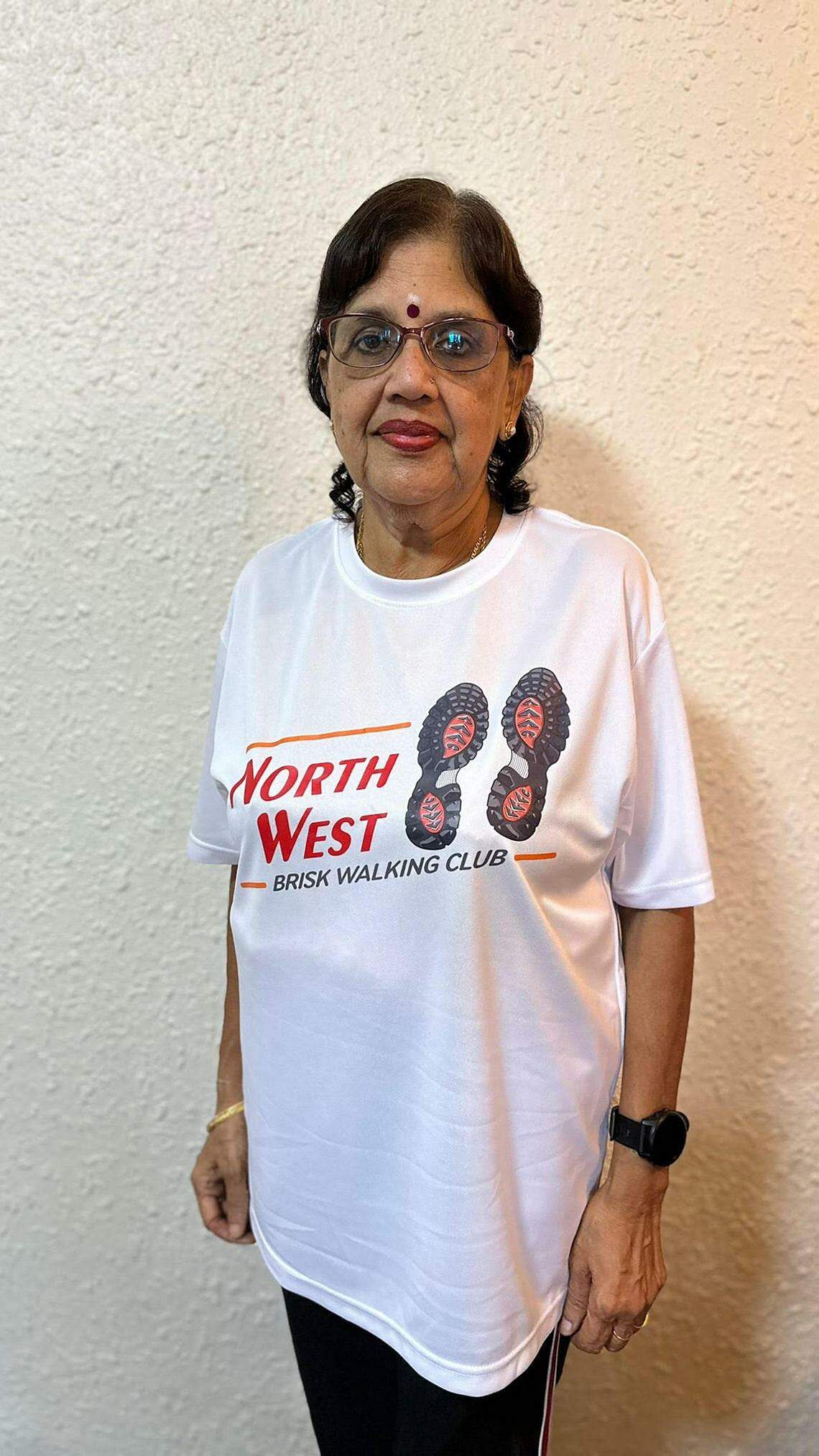
Joining a walking group has done wonders for Madam Sandakumari Kannapathy, 73, who has been living alone in Marsiling since her husband, who worked as a manager, died 18 years ago.
She has two married daughters. One lives nearby, and the other has migrated to Australia. Her four grandchildren, aged between 18 and 24, sometimes stay over. But most of the time, she is alone at home.
“After losing my husband, I didn’t feel at peace. I was very down. I told myself I couldn’t stay like this. I needed to move on. My friends told me that walking would be good for me,” says the widow, who suffers from hypertension and diabetes.
In 2021, her friend introduced her to the North West Brisk Walking Club. Since then, she has spent each Saturday morning with more than 20 members of the group, walking for about an hour or two around their neighbourhood.

The North West Brisk Walking Club is a healthy living programme, launched by the North West Community Development Council in 2002. It has grown to become the largest brisk walking club in Singapore, with more than 60,000 members, mostly in their 60s and 70s, across 158 groups.
All members get a card, which is stamped each time they attend a walk. At the end of the year, members get supermarket vouchers based on the number of stamps earned: a $5 supermarket voucher for every 25 stamps, and a $25 supermarket voucher for 45 stamps and above.
For Madam Sandakumari, that is just a small perk. She says her biggest rewards are improved energy levels and new friendships.
“We don’t feel tired, because we are walking and talking. We talk about where we want to have breakfast, what we are going to do after the walk. Before you know it, wow, we have walked 3.3km,” says Madam Sandakumari, who enjoys her walks so much she has encouraged four neighbours to join the group.
Ms Cristina Gonzalez, a therapist with Alliance Counselling, sometimes employs a method of psychotherapy called “walk and talk” with her clients.
Instead of sitting inside an office for a therapy session, she and her patient go for a walk at the Singapore Botanic Gardens and East Coast Park, among others.
Studies have shown the incredible benefits of combining psychotherapy and walking, she says.
“I use the walk as an analogy for my patients. We are not stuck, things are happening. We are going somewhere, and we are working on it. The body always informs the brain,” she says.
Ms Gonzalez sees many mental health benefits that can come from joining a walking group.
“Socialising is a key point in self-care. During Covid-19, human connection was lacking,” she says.
“Being in contact with nature also helps you sort out your emotions and be calmer.”
In 2022, Ms Michelle Wong, 56, a manager at a media company, went on a hiking holiday to South Korea with friends. She enjoyed it so much that when she came back to Singapore, she looked for hiking activities she could do here.
In January 2023, a former colleague introduced her to an interest group that organises overseas hikes and conducts hiking training locally. On that first training day at Rifle Range Nature Park, she met Mr Alvin Lok, 60, a regular with the group.

Mr Lok, a town council property officer, says: “She attracted my attention because she was outspoken, lively and very loud.”
As the group walked through the nature park, he walked next to her and told her: “Follow my pace.”
They started chatting and the connection was instantaneous. Both are divorced with adult children and have a shared interest in outdoor activities.
Ms Wong recalls: “The third time we hung out, we hiked a mountain in Malaysia and that terrain was difficult. I was scared of falling down. So he offered help, and that’s how we got closer.”
Within a month of getting to know each other, they were a couple.
A few months ago, Ms Wong chanced across the Facebook group LongwalkSG. Unlike other walking outfits, the group tries to cover an average of 25km to 30km per walk. She and Mr Lok decided to join LongwalkSG, and now attend at least one walk with the group each week.
Mr Lok likes that the walks are well-planned and well-organised.
“You don’t have to worry about what’s your route because that has been mapped out by the organiser,” he says.
In April 2024, the couple participated in an overnight cross-island walk organised by LongwalkSG that started at Raffles Marina Lighthouse in Tuas and ended the next day at Changi Beach Park.
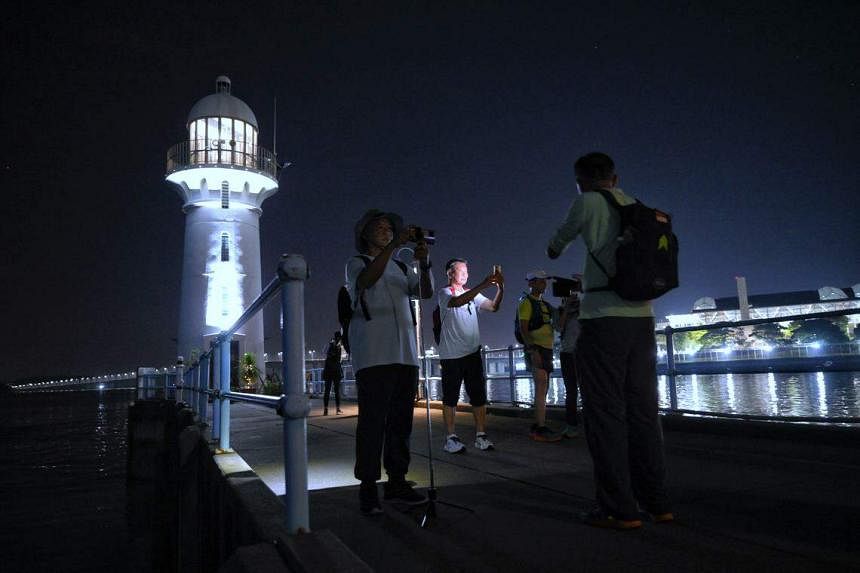
The group walked more than 78km over 18 hours, taking short breaks for meals.
Ms Wong says: “My job can get quite stressful. When I exercise, it’s the only time I don’t think about work. I used to walk alone at Bedok Reservoir after work. Now, I have a partner to walk with, we really enjoy walking as a form of quality time.”
With more than 380km of walking and cycling paths spread out across the Park Connector Network, walkers in Singapore are spoilt for choice.
The Park Connector Network was conceptualised in 1990 and approved by the Garden City Action Committee in 1991.
The first completed park connector was officially opened on Aug 14, 1992, along the Kallang River, linking Bishan-Ang Mo Kio Park to Kallang Riverside Park.
To date, there are about 380km of park connectors islandwide. The National Parks Board (NParks) aims to increase the length of park connectors to 500km by 2030.
Meanwhile, the first phase of the Round Island Route was launched in January 2022. Stretching across 75km, it covers the eastern half of Singapore, from Rower’s Bay Park in the north-east, past the Singapore River to Berlayer Creek in the south. When the remaining half is completed by 2035, the Round Island Route will be the longest recreational connection looping around the island.
Bored and frustrated from being cooped up indoors during the pandemic, Ms Suchi Param looked up walking groups on Meetup.com.
Walking has always been an integral part of her life. The freelance trainer and facilitator lives close to the MacRitchie Reservoir.
Over the years, Ms Param, 55, and her mother, who is in her late 80s, have taken long walks to spend quality time together.
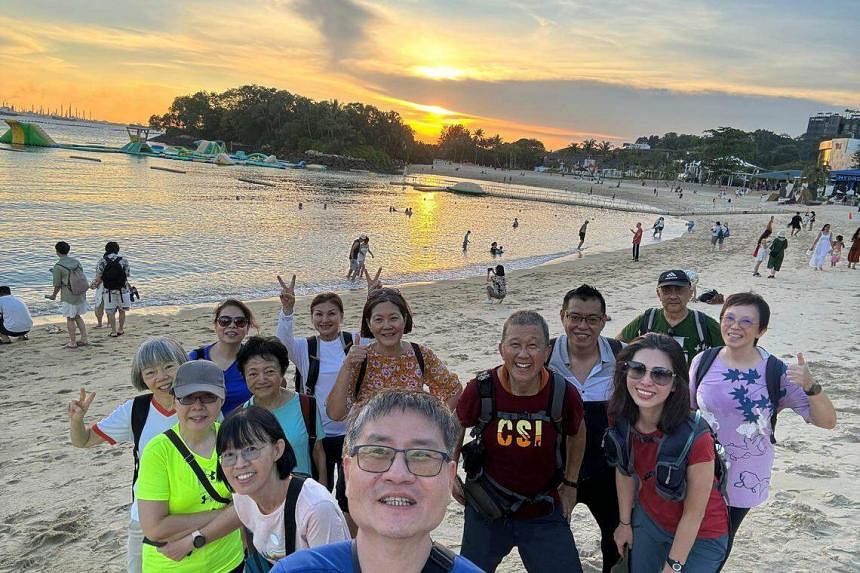
She came across I Walk I Hike I Eat I Travel – a group led by Mr Ethan Lee, who works part-time in the legal industry.
Each week, the group explores nature walks and urban trails all over Singapore such as in Bukit Brown Cemetery, Katong, The Lone Tree at Jurong Lake Gardens, and the Southern Ridges.
Ms Param now walks with the group regularly on Thursday and Sunday evenings, and has even become a co-host. Together with other co-hosts, she tests out routes ahead of time to assess their suitability.
“When we walked from Buona Vista to Jurong East through the Ulu Pandan Park Connector, I was thinking: ‘I’m always going past Jurong East and Buona Vista on a train, but this is so different’,” she says.
“What really excited me was the realisation that there was so much to explore, and we took it for granted. It’s like being a tourist in your own country.”
She has gained so much satisfaction and knowledge from exploring her own backyard that travelling abroad has taken a backseat.
“I’m getting the same kind of dopamine and satisfaction every weekend with my walk that I used to get from travelling. There are many opportunities to really get to know people and expand your social circle,” says Ms Param, adding that the group caps off each walk with a shared meal.
Cities around the world have different walking cultures.
In April 2024, insurance company Compare the Market Australia ranked the most walkable cities in the world. Munich, Milan and Warsaw – all European cities – came out on top, judged on factors such as their number of walking trails, rainfall and car-free places.
In 2016, sustainable development consultancy Arup released a report titled Cities Alive: Towards A Walking World, which examined the role walkability plays in developing more liveable and attractive cities.
Dr Kristian Steele, Arup’s Singapore leader for climate and sustainability services, says: “In many Asian cities, including Singapore, I observed a hierarchy in road users, with pedestrians coming out at the bottom.
“Drivers often give short notice to pedestrians or cyclists. By contrast, I see the opposite in other countries, particularly in Europe, with space or priority given to walking and cycling, and the protection of those users.”
Arup’s report found that walkable cities provide a number of social and environmental benefits, such as increased population health, general well-being and reduced noise and air pollution.
Designing walkable cities, according to the report, also has economic benefits. Investing in better streets and spaces for walking can provide a competitive return compared with other transport projects. Cycling and walking are estimated to provide up to $11.80 for every $1 invested – a more than tenfold return of investment.
“In Singapore, park connectors are now used for leisure. Could we actually use them as a mode of transport to get to school, get to work? It’s not being looked at in that way yet,” says Dr Steele.
“Singapore is a great environment that can continue to be trialled and developed because of its scale.”
In March 2023, the Land Transport Authority set out a plan to create what it calls Friendly Streets, an initiative incorporating elements from existing efforts to improve walkability and pedestrian safety.
It aims to make walking and cycling daily to key amenities in the neighbourhoods safer, as well as more convenient and comfortable.
Features include wider footpaths, dedicated cycling paths, barrier-free pedestrian crossings and traffic-calming measures – such as road markings and lower speed limits – aimed at slowing motorists down.
Friendly Streets is currently being piloted in five neighbourhoods – Ang Mo Kio, Bukit Batok West, Tampines, Toa Payoh and West Coast – with plans to be implemented in all towns by 2030.
Simpang Kiri Park Connector: Rich in natural vegetation and a favourite haunt for birdwatchers, this trail passes through the rustic Masjid Petempatan Melayu Sembawang, a mosque with historical significance. (pcn.nparks.gov.sg/simpang-kiri-pc)
Lornie Park Connector: The connector buffers the Central Catchment Nature Reserve and is part of the Coast-to-Coast Trail.(pcn.nparks.gov.sg/lornie-pc)
Punggol Park Connector: Built around Singapore’s largest man-made waterway, this connector features unique bridges. (pcn.nparks.gov.sg/punggol-waterway)
Changi Bay Park Connector: The scenic coastal route has waterfront views and a lookout pavilion. (pcn.nparks.gov.sg/changi-bay-pc)
NParks encourages all visitors to be considerate of others and the environment while enjoying park connectors and nature trails.
Designated trails in the nature reserves and parks are identified by map boards, directional signs and trail markers.
Park connector users should stay on their designated paths, and abide by the safety guidelines and on-site signage.
ALSO READ: Weekend trail? 21km continuous walking trail from Kranji MRT station to near Tanjong Pagar opens
This article was first published in The Straits Times. Permission required for reproduction.